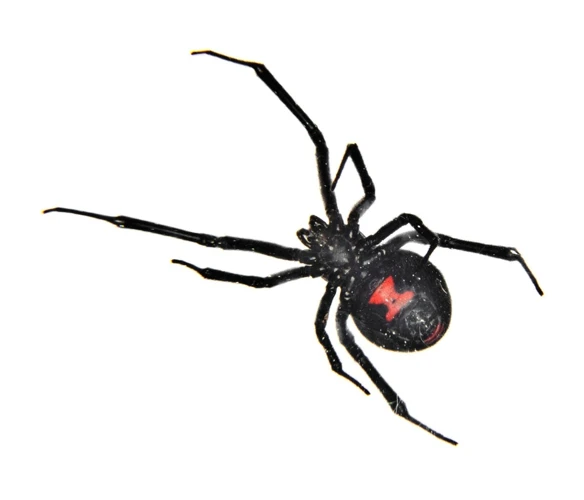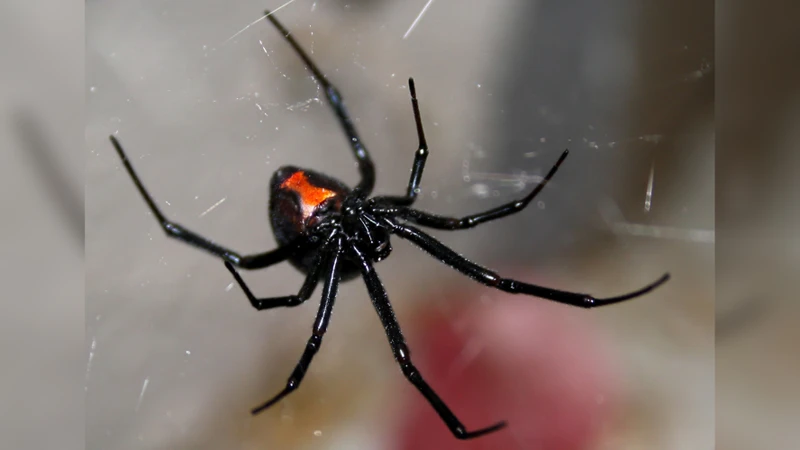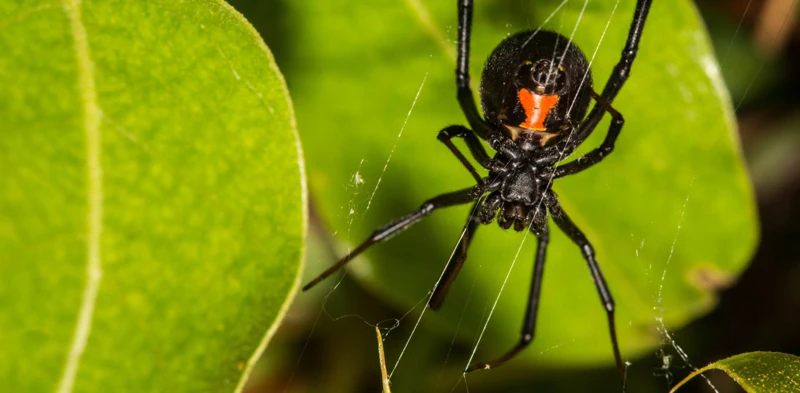As we explore the fascinating world of nocturnal predators and the black widow spider, an intriguing question arises – what is the relationship between these creatures? Do they coexist peacefully or are they natural enemies? The black widow spider is notorious for its venomous bite and nocturnal behavior, while a wide range of predators lurk in the shadows after dark. In this article, we dive deep into the interaction between black widow spiders and nocturnal predators, exploring their types, common interactions and ecological significance. Join us as we uncover the mysteries of these intriguing creatures and their relationship in the wild.
What are Nocturnal Predators?

Have you ever wondered what creatures roam around at night? Nocturnal predators are animals that are active during nighttime hours and rely on their superior senses to hunt and capture prey. These animals have adapted to life in the dark, developing specialized physical features and behaviors that allow them to see, navigate, and hunt in the absence of light. Black widows spiders are one of the nocturnal creatures that rely on the cover of darkness to hunt and avoid being hunted. To learn more about these fascinating creatures and the relationships they share with nocturnal predators, continue reading. You may also be interested in reading about black widow spiders hunting at night or strategies for black widow spider predators at night.
Types of Nocturnal Predators
Nocturnal predators are creatures that hunt or forage at night, and they come in many different shapes and sizes. Some are carnivorous mammals like foxes, coyotes, and bobcats, while others are avian predators such as owls, nightjars, and bats. Additionally, certain reptiles like snakes, lizards, and geckos, as well as arachnids such as scorpions and spiders, are also nocturnal hunters. Among these, the black widow spider is one of the most fascinating and controversial due to its venomous bite and nocturnal habits.
In fact, black widow spiders are known for being primarily nocturnal, which means that they are most active during the night and sleep during the day. This behavior is thought to have a number of benefits for the spider, including reduced exposure to predators and higher success rates in capturing prey.
Nocturnal predators in general have evolved to take advantage of the unique opportunities afforded by the darkness. As such, they often rely on highly-developed senses other than sight, such as hearing, smell, and touch, in order to navigate and locate prey. For example, owls have excellent hearing and can detect the slightest movements of their prey, while bats use echolocation to navigate in the dark.
Despite the challenges of hunting at night, nocturnal predators are often very successful in capturing prey, particularly because their prey is also generally more active at night. This has led to many interesting adaptations among nocturnal predators, such as special vision that allows them to see in low light or the use of venom to subdue their prey.
The diversity of nocturnal predators is vast and fascinating, and their interactions with other nocturnal creatures like black widow spiders can be complex. By studying these interactions, scientists can gain a better understanding of the ecosystem as a whole and the role that each species plays within it.
Black Widow Spiders and Nocturnal Predators

Black widow spiders are one of the most recognizable species of spiders, known for their striking appearance and venomous bite. These spiders are commonly found in warm climates around the world, and they have adapted to a nocturnal lifestyle. As a result, they often interact with other nocturnal animals, including predators. Understanding the relationship between black widow spiders and nocturnal predators is important for understanding the spider’s ecological role and conservation implications. In this section, we’ll delve into the details of this fascinating relationship.
Common Predators of Black Widows
Black widow spiders have a range of predators that are active at night, and these predators can include birds, lizards, and certain species of mammals. Birds, such as owls and mockingbirds, have been known to prey on black widow spiders. Lizards, such as the collared lizard, have been observed to not only prey on black widows but also have developed a certain level of immunity against their venom.
Small mammals, such as shrews and rodents, can also prey on black widows. For example, the common house mouse is known to feed on black widow spiders in certain areas. However, it is important to note that while these predators can hunt and kill black widows, they also run the risk of being bitten themselves.
It’s also worth mentioning that the nocturnal behavior of black widows is a way to avoid some of these predators. By being most active at night, they reduce their chances of being hunted by diurnal predators. Meanwhile, aerial predators like birds will have a hard time seeing them in complete darkness.
The range of predators that black widow spiders face underscores the importance of their nocturnal behavior and web-building abilities to defend against these predators. To learn more about the nocturnal behavior of black widow spiders, check out our article on black widow spiders at night.
Black Widow Predation on Other Nocturnal Predators
There are some instances when black widow spiders are not the prey, but the predator. Interestingly, black widow spiders are known to prey on other nocturnal predators such as scorpions, centipedes, and even other spiders.
Scorpions are known to be one of the prey of black widows, and this may be attributed to the fact that black widows are immune to their venom. In a study conducted by researchers from the University of California, Riverside, a female black widow spider was able to successfully consume a male bark scorpion in just a few hours. According to the researchers, the spiders are capable of paralyzing the scorpion by injecting them with their potent neurotoxin.
Aside from scorpions, black widows are also known to prey on centipedes. Although less commonly documented, black widow spiders have been observed feeding on these arthropods, which are known for their venomous bite.
Black widows are known to engage in cannibalism, which involves the predation of their own species. Female black widows have been documented consuming males after copulation, earning them their infamous name. However, it is important to note that not all females engage in this behavior.
The ability of black widow spiders to hunt other nocturnal predators highlights how this species is an important player in the ecosystem. Their predatory behavior allows for control of other arthropod populations which can become overabundant in their respective environments.
Internal link: Learn more about the benefits of black widow’s nocturnal behavior.
Here is a table illustrating some of the prey of adult black widow spiders:
| Prey | Frequency of Predation |
|---|---|
| Scorpions | Common prey |
| Centipedes | Less commonly documented |
| Other spiders | Cannibalism or opportunistic predation |
Ecological Significance
The interdependence between black widow spiders and nocturnal predators extends far beyond simple predator-prey relationships. The ecological significance of this dynamic is far-reaching and significant. Understanding the ways in which black widows and their predators interact can lead to a deeper understanding of the delicate balance of nature. In this section, we’ll explore the impact that black widows and nocturnal predators have on their environment in several critical areas.
Impact on Food Webs
The impacts of the relationships between black widow spiders and nocturnal predators extend far beyond their direct interactions. Food webs are dynamic and complex, and the presence or absence of a predator or prey species can have a ripple effect on the entire system.
Black widow spiders primarily prey on insects like moths, beetles, and cockroaches. These insects, in turn, may be important prey for other predators such as bats and birds. If black widow populations were to decline significantly, this could potentially impact the populations of their prey species and the predators that rely on them.
Conversely, if there were an increase in nocturnal predator populations, such as bats and owls, this could lead to a decrease in black widow spider populations. This could have indirect effects on the rest of the food web, as well. For example, an increase in insect populations due to a decrease in black widow spider predation could potentially lead to an increase in herbivorous insect populations.
Changes in black widow spider populations can also have cascading effects on other aspects of the ecosystem, such as vegetation and nutrient cycling. For example, if herbivorous insect populations were to surge due to a decline in black widows, they could potentially damage vegetation and disrupt nutrient cycling in the ecosystem.
It is important to study and understand the relationships between black widow spiders and nocturnal predators to gain an appreciation for the complexity of food webs and the impacts of changes in predator and prey populations. Further research on this topic is needed to improve our understanding of this dynamic relationship and its implications for ecosystems.
Conservation Implications
Conservation Implications:
Black widow spiders are not often considered in conservation efforts due to their sometimes dangerous reputation. However, as important members of nocturnal ecosystems, they play a vital role in maintaining ecological balance. Their presence in food webs helps to control populations of various nocturnal predator species, including insects, small mammals, and other spiders.
As human populations continue to expand and urbanization spreads, black widow spider habitats are being destroyed and fragmented. This loss of habitat, coupled with pollution and light pollution, puts significant pressure on their populations.
There are several conservation implications for black widow spiders, including:
| Conservation Issue | Implications |
| Loss of habitat | As black widow spider habitats are destroyed and fragmented, their populations face the risk of decline and even extinction. |
| Pollution | As pollution levels increase, the ability of black widow spiders to move and hunt is reduced. This can lead to reduced populations and decreased ecological balance. |
| Light pollution | Artificial lighting can disrupt natural cycles of activity, reduce nocturnal predator populations, and reduce the ability of black widow spiders to hunt and navigate. |
Efforts to preserve and conserve black widow spider habitats, reduce pollution, and minimize light pollution can help to protect their populations and maintain ecological balance. It is important to recognize their ecological significance and work towards preserving their place in nocturnal ecosystems.
Conclusion
In conclusion, the relationship between black widow spiders and nocturnal predators is complex and multi-faceted. Black widow spiders have evolved various defense mechanisms to avoid predation, including their venomous bite, silk-slinging capabilities, and nocturnal behavior. They are also known to be opportunistic predators, feeding on other nocturnal predators.
The presence of black widow spiders in nocturnal ecosystems can have significant ecological significance, impacting the food webs and predator-prey dynamics. The conservation implications of black widow spider populations are also worth considering, as their role in the ecosystem may be crucial to maintaining balance and diversity.
To further understand the behavior and lifestyle of black widow spiders, it is worth exploring their seasonal behavior, silk-spinning habits, navigation in the dark, response to artificial lighting, and nocturnal tendencies of spiderlings and male black widow spiders. By studying these aspects of their behavior, we can gain a better understanding of these fascinating and often misunderstood predators.
Frequently Asked Questions
What is the difference between diurnal and nocturnal predators?
Diurnal predators hunt during the daytime, while nocturnal predators hunt during the nighttime.
What are some examples of nocturnal predators?
Some examples of nocturnal predators include owls, bats, coyotes, and foxes.
How do black widow spiders protect themselves from predators?
Black widow spiders use their venomous bite and silk webs to protect themselves from predators.
What are some common predators of black widow spiders?
Some common predators of black widow spiders include birds, rodents, and theridiid spiders.
Do black widow spiders prey on other spiders?
Yes, black widow spiders are known to prey on other spiders, particularly theridiid spiders.
What is the ecological significance of black widow spiders?
Black widow spiders play an important role in their ecosystems as predators, controlling populations of insects and other small animals.
What is the impact of black widow spiders on food webs?
Black widow spiders are an important part of food webs, as they are both predators and prey. They can help control populations of insects and other small animals, but can also be a food source for larger predators.
Are black widow spiders endangered?
No, black widow spiders are not currently considered endangered. However, the degradation of their habitats does pose a threat to their populations.
What can be done to protect black widow spider populations?
Protecting and preserving their natural habitats is important for maintaining healthy populations of black widow spiders. Additionally, minimizing the use of pesticides and other chemicals can help reduce harm to these spiders and their prey.
Can black widow spiders be kept as pets?
While some people may choose to keep black widow spiders as pets, it is not recommended due to their potentially dangerous venom. It is also illegal to keep some species of black widow spiders in certain areas.






